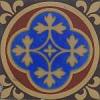
Batch bread in wooden frames
I was reading how UK bakers, especially in Scotland and Ireland, used to bake their batch loaves in wooden frames. That's right - the wooden frame goes INTO the oven! Originally, the bakers didn't even use a frame - it was just lengths of heavy timber inserted into the oven defining a rectangle with the dough pieces inside the rectangle. Interestingly, these lengths of wood were called "upsets".
There's a Scottish baker, Wild Hearth Bakery, who does these batch loaves to perfection. Some regional German breads are also baked the same way.
The idea was so wacky, I just had to try it! Like all new things baking, the journey turned out to be a lot longer than expected....
So I made a simple frame designed for 2 loaves. Oak for 2 sides and maple for the other 2 - just what I had available. I guessed at a size of 5" tall x 9" x 6 3/4" internal. Simple butt joints screwed together:

I made white yeasted bread based on a 4 hour sponge. Baked for 1 hour at 200C Two main problems: the dough stuck badly to the wood (even though oiled well multiple times) and not enough rise.




I then read that the frames should be oiled and baked empty for 60 mins at 190C. This certainly eased the sticking problem, especially if the frame is oiled and floured before use.
The second bake was similar to the first, but with the sticking problem more or less solved. This helped the loft. It was a lot bolder, too:

Both bakes had excessively thick bottom crusts. I'd baked with the frame sat on a thin baking sheet which was then placed on my bake stone. So for bake 3, I did away with the bake stone and used another thin steel baking sheet instead. This worked fine.
I also get fed up of nearly white bread and did a 100% sponge enriched dough with 20% freshly milled heritage wheat (Millers Choice) and SD levain along with the yeast.
This solved the rising problem, but introduced problems of its own, with the loaf sides collapsing in with a doughy strata in there as well.
Probably reducing the hydration will solve this. Another problem is that the outer wall of the loaf (in contact with the wood) never rises as high as the inside wall so the loaves are lop-sided - I think this is a known fact.




Although this loaf looks worse than the earlier ones, it's actually very tasty!
So quite a journey - and more to do!
Will I carry on? Sadly, probably not, as I don't find any advantages in the loaves or their flavour. Some say there is a woodyness or smokiness there, but if so, it's very subtle.
It's also quite a chunk of hardware to have lying in the kitchen (somewhere).
Still, it was a good learning curve!
Lance


Comments
Thanks Lance. I enjoyed reading about the history and your attempts. There are so many interesting bread innovations over the centuries.
Here is The Rye Baker using a wooden frame for apple rye from Austria. Nice write up. I've wanted to do the apple rye for quite some time.
Nice bake. They look like milk loaves.
Thanks, fun read. The wood would be a major insulator around the perimeter... the link to Ginsberg confirms this in a story that it was used to create cakes with less crusty perimeters.
I guess heat and bake times would have to be adjusted to compensate for that insulation factor. For some breads, those conditions might work well.
Great set of experiments Lance, I applaud your openness to trying new things.
Benny
Thanks everyone - and Abe, that's a good recipe you link to; I might try it sometime.
I think the whole excercise shows that if you go off on your own into the baking wilderness, you need to be prepared for a lot of work, and a few failures on the way.
Still, to borrow from TFLs Ananda (Andy) " I like making numerous different breads for variety and to keep up with the craft, and continue to push my own boundaries."
Lance
Looking forward! Lance.
We now offer a batch bread frame made by Campbell from RackMaster!